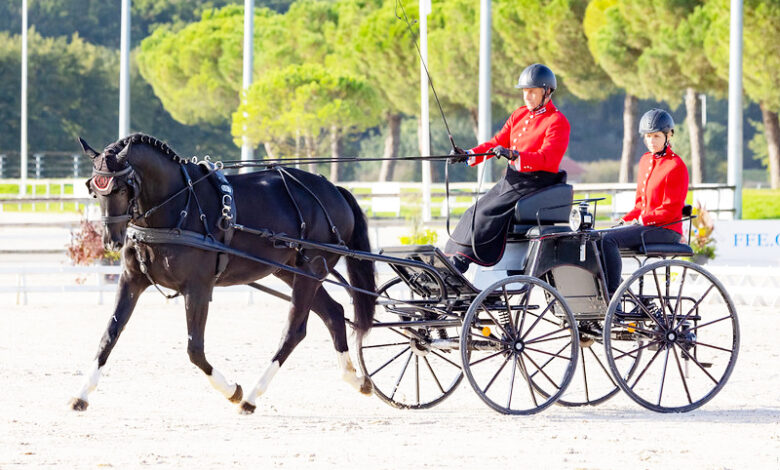
Venturing outside Hungary for the first time since the event was established in 2016, the 7th FEI Driving World Championship for Young Horses was held at the superb equestrian centre Parc Equestre Fédéral at Lamotte-Beuvron, south of Orleans (FRA). It has been a busy time for the French as the event followed the FEI World Pairs Championship in Haras-du-Pin in Normandy last weekend.
First to be crowned World Champion on a bright Sunday morning was Swiss singles supremo Mario Gandolfo in the 6-year-old class with the Franches-Montagnes Lemmy-K, owned by Lisby Bastin. Maintaining the winning momentum he showed last year to win the 5-year-old title in Szilvásvárad (HUN), the powerful Swiss bred gelding was in front at each stage of the competition to end on 15.93. Mario is currently ranked number two in FEI Singles. Runner up was Lars Krüger (GER) with the German Sathu mare Salome on 14.80 and in third was Sabrina Melotti (NED) driving the KWPN mare Melotti Texel with 13.67.
The next class to find a new champion was for the youngest category, the 5-year-olds. Fabrice Martin (FRA), driving for the host nation also led at each stage with the stunning black Selle Français mare Idromel Noir owned by the IFCE and they topped the leaderboard with 15.30. Matching his position from the previous class, runner up once again was Lars Krüger with the Sathu stallion Valentino on 14.12. And trading a first for third, Mario Gandolfo drove his own Franches-Montagnes gelding Johnson Du Signal to take the remaining podium place with 12.98.
Despite a slight delay to the start of Sunday’s competition due to water problems in the arena, by late lunchtime the third title of the weekend had been awarded in the 7-year-old category to Marie Schiltz (LUX). Currently ranked number three in FEI Singles, Marie was another to lead throughout the competition driving her father Franz’s Oldenburg mare Freaky Friday 12 to end on 14.53, who impressed the judges with her supple and uphill movement. Franz drove the mare two years ago in the 5-year-old category but he is also a previous world title winner in the 7-year-old category, which he took at the first World Championship in 2016 with his Oldenburg stallion Frodo, who Marie now drives.
Placed second was Wilbrord Van Den Broek (NED) with his own KWPN gelding Love to Dance with a total of 12.46, marginally ahead of Agnes Paulovics (HUN) with Józef Vida’s KWPN stallion L-Grappa-WK on 12.31. As well as appearing at the last two Young Horse World Championships, where he was third last year in the 6 yo class, this versatile horse also drives in Józef’s Four-in-Hand, and with Agnes competes in Horse Singles classes.
The competition, like other championships, takes place over four days, after the initial ‘fit to compete’ inspection. However, in all other areas the format is different. On Thursday, athletes and horses enter a qualifying ‘Aptitude Test’ which combines a series of Dressage movements and a sequence of Cones. The top 50% proceed to the Dressage on Saturday but on Friday, the lower 50% drive again to try again to gain a place in the final phases. The number permitted to through after the second qualification is determined by the officials, but there is a maximum of ten athletes in the final rounds for each class.
Sunday’s Combined Marathon takes place in one arena and consists of two Marathon type obstacles plus Cones, but the course varies between the classes to alter the complexity depending on the age category, for example in the 5-year-old class, only one of the Marathon obstacles was used. The course designer was Josef Middendorf, who also designed at the Four-in-Hand World Championships in Pratoni (ITA) last year.
The marking system is also different from most Driving competitions which are penalty based, so the lowest overall score wins. Here it is the highest score which wins and marks are awarded together by the four judges who decide collaboratively what mark out of 10 will be given, which is then averaged to give a single mark at the end of each phase.
For the final placings, two marks count which are from the from the Dressage and the Combined Marathon. Penalties are deducted from the total and can be for a knocked ball, which is 0.3, or for time and other errors such as a groom down.
“Having the judges sit together allows for really good discussion around the way of going expected from the age range. The key point is this is judged around the performance of the horse, not a series of Dressage movements. It is refreshing to look at the horse according to age and have a good discussion between colleagues. It is also important to understand how we train horses correctly, giving them time to develop and mature. It’s such a special event, being able to look at some amazing horses and really getting into the movement, training scale, and minds of some wonderful equines.” – Andrew Counsell, President of the Ground Jury said.
In total, 50 athletes and 50 horses came forward from 10 nations. Athletes compete as individuals and there is no team competition. Each athlete can enter two horses per age category. Throughout the event, the emphasis is on the performance of the horse. Marks are given in accordance with the scales of training in the context of the age and stage of its development.
FULL RESULTS HERE
